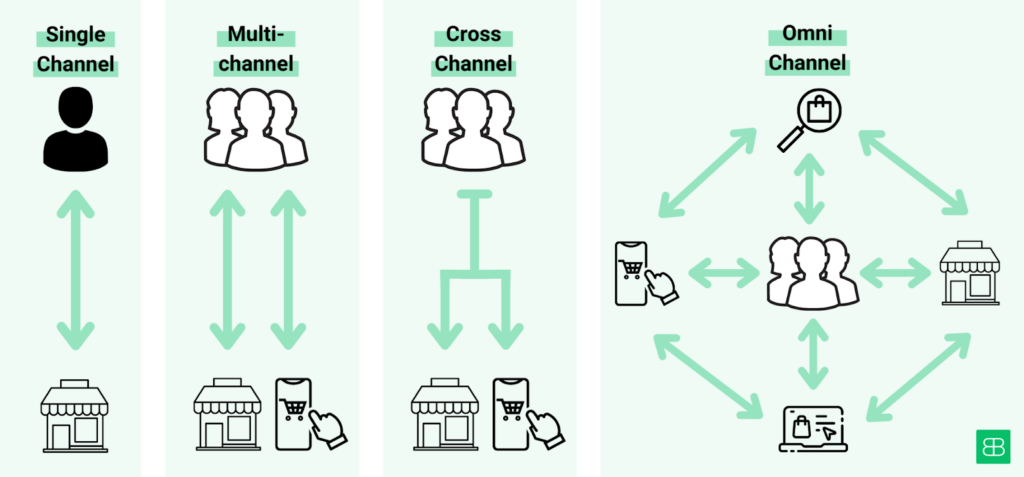E-commerce is one of the winning industries of the pandemic. In recent years, online sales have exploded, making e-commerce an important part of sales for many businesses and retailers.
In e-commerce, it's no longer just about the products you sell, but more importantly, the channels through which you sell them. The multichannel approach is particularly promising for online retailers. Whether you've been an online retailer for years or are just starting your business, the right time to enter multichannel is now. In our blog post, we'll show you three tips for a better start.
Table of Contents:
What is multichannel in sales exactly?
There are different sales models that differ in the number and connectivity of sales channels: Single Channel, Multichannel, Cross Channel, and Omni Channel. The latter three models can also be referred to as cross-channel sales models.
Single Channel sales are the simplest sales model. Here, you limit yourself to a single channel, such as your own online store. No marketplace, no physical store - just you and your shop. Similarly, you can only sell on a marketplace, without simultaneously operating an online store or physical store. Many retailers are traditionally single-channel sellers, as they only have their physical store as a sales channel. The pandemic has given many retailers the impetus to switch from a single-channel to a multichannel sales model. If physical retailers expanded their physical store with an online store, they suddenly found themselves in multichannel sales.
When you expand your single-channel sales to one or more channels, you have entered the multichannel sales model. Here, you sell not only through your own online store but also through other channels such as marketplaces or physical stores. Unlike the other cross-channel sales models, you operate the channels here independently and alongside each other.

Wir wollen auch den Crosschannel und Omnichannel Vertrieb nicht außer Acht lassen. Beim Crosschannel-Vertrieb arbeiten die verschiedenen Kanäle Hand in Hand und bauen Barrieren zwischen den Kanälen ab. So können Kunden und Kundinnen auf verschiedenen Stufen ihrer Customer Journey an unterschiedlichen Stellen mit dir und deinen Kanälen interagieren. Ein Beispiel dafür ist das beliebte „Click and Collect“-Prinzip, bei dem die Kundschaft online bestellen und die Ware im Laden abholen kann. Der Omnichannel-Vertrieb vereint alle Modelle in einem und ermöglicht es der Kundschaft, während des Einkaufs mehrere Kanäle gleichzeitig zu nutzen, wie beispielsweise das stationäre Ladengeschäft und ein Smartphone oder Tablet. Die Kunden und Kundinnen können auch auf ihre Kundendaten zugreifen, was den Check-out-Prozess erleichtert.
Benefits of Multichannel Sales: Why it's worth it!
There is a reason why both large, established brands and merchants who are just starting out in e-commerce rely on multichannel sales, as it brings several advantages:
-
- Your reach expands: The more channels you use, the larger your target audience becomes as you offer your products where potential customers are. For example, if you only run a physical store, your target audience is usually limited to a specific regional area. However, according to a survey by SoloBusinessTribe , 85.7 percent of Germans shop online more than once a month. Therefore, by also using online channels, you can reach more people in your target audience, regardless of their location, as this plays a minor role when shopping online.
- Your business risk is minimized: Setting up your own online store can be associated with a high resource effort. You have to invest a lot of time and money without knowing if your store will be successful. As an alternative to your own online store, it may be worth being present on marketplaces initially. The presence on marketplaces often requires less resources than building your own store. Of course, one should not exclude the other: if you already operate a successful online store, it may also make sense to expand sales activities to marketplaces.
- Your sales increase: By expanding your target audience through a multichannel strategy, you can usually also increase your sales figures and therefore your revenue. With every additional channel on which you are present, the visibility of your company also increases. By targeted measures such as SEO-optimized product descriptions or targeted advertising campaigns on various channels, you can further increase this visibility. This way, you not only reach more potential customers, but also increase the likelihood that they become customers.
Your competitiveness increases: To be successful, it is important that you select your sales channels purposefully. After all, you want to sell where your potential customers are. A great online store and great products alone are useless if nobody knows about them. Therefore, you should deal with your competitors and analyze their sales channels. Which channels do they use and where are they particularly successful? From these insights, you can derive which sales channels could be relevant for you. This way, you can invest in these channels purposefully and increase your chances of success.
The advantages that multichannel sales bring for online merchants are obvious. But how can beginners achieve a good start in their multichannel strategy?
3 Tips for a Successful Start in Multichannel as an Online Retailer
Isn't having a presence on multiple sales channels also more work? After all, the same tasks apply to each channel as to your existing online shop, such as shipping, product maintenance, and communication with customers. But don't worry, we have three helpful tips for you to make sure Multichannel doesn't become a stumbling block:
Tip #1: Efficiently and successfully structuring processes in multichannel
Many online retailers start their online business alongside a full-time job, often even from their own living room with a storage in their own garage. However, as the number of orders increases, it becomes increasingly difficult to keep track of everything. You may even be overwhelmed by the growing order volumes and the responsibilities that come with running a successful business. The magic word here is “processes.”
Those who want to be successful cannot neglect structure and order. An efficient multichannel strategy requires a coordinated order processing and a smooth interaction of all sales channels as well as all downstream processes (e.g., warehouse logistics,accounting, Returns).
Therefore, you should regularly take the time to rethink and improve your existing processes. Set aside time in your calendar for organizational work and avoid distractions to really work effectively on organizing your business. As an online retailer, you know that time is money, so you should use it consciously to be successful in the long run.
Tip #2: More time for the essentials with automation
To simplify the work in multichannel sales, we recommend automating workflows. Automation is a topic that many online retailers, especially in the beginning, say they don't need because they don't have enough orders for automation to be worth it. But automation is worth it from the first order!
Sobald eine Bestellung über deinen Online-Shop oder einen deiner Marktplätze eingeht, beginnt die Vorbereitung und Abwicklung des Auftrags, wie das Verpacken der Artikel, das Erstellen von Rechnungen und Versandetiketten sowie das Versenden von Versand- und Tracking-Informationen an die Kund:innen. Durch Automatisierung können viele dieser Arbeitsschritte automatisch und ohne weiteres Zutun im Hintergrund ablaufen. Dazu wird in der Regel ein Softwaretool verwendet, das die Bestelldaten aufnimmt und damit Automatisierungen auslösen kann. Typische Automatisierungen im E-Commerce umfassen unter anderem das Erstellen und Versenden von Rechnungen und Versandlabels, die Kommunikation mit der Kundschaft (z.B. Versenden von Tracking-Informationen, Zahlungsbestätigungen und -erinnerungen) und das Fulfillment durch externe Dienstleister.
Automating processes saves time and gives you the opportunity to focus on other tasks, such as planning marketing campaigns or expanding your product offerings.
Tip #3: Keeping an overview is the key to success
In einem Multi-Channel-Umfeld ist es wichtig, den Überblick über alle Bestellungen, Shops und Verwaltungsaufgaben im Unternehmen zu behalten. Bei einer wachsenden Anzahl von Kanälen müssen z.B. Artikelbestände und -informationen auf allen Kanälen stets aktuell gehalten werden, um Überverkäufe zu vermeiden. Denn zufriedene Kunden und Kundinnen kaufen erneut bei dir ein, während unzufriedene Kundschaft abspringt.
To avoid chaos, you should look for tools that can help you. With a tool designed specifically for multichannel merchants, you can easily keep track of everything. All orders, regardless of which platform they come from, are consolidated in one software. If you can manage all orders in one place, you avoid unnecessary extra effort and information can be updated across channels. Billbee is such a software that combines product management, order processing, and automation in one tool.With its integration with various shop systems and marketplaces, Billbee is particularly suitable for multichannel merchants to keep track of everything. Warehousing1 can also be seamlessly integrated into Billbee. In addition to its easy and self-directed setup, Billbee also offers the ability to connect with various other tools from all e-commerce-relevant areas. Try Billbee now for 30 days for free and without obligation, and then decide if it's the right tool for you!



